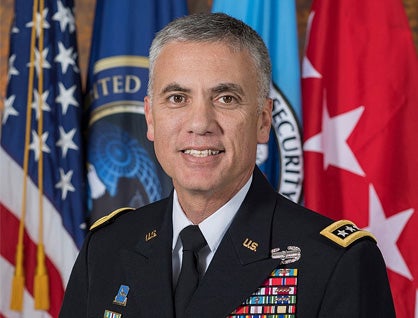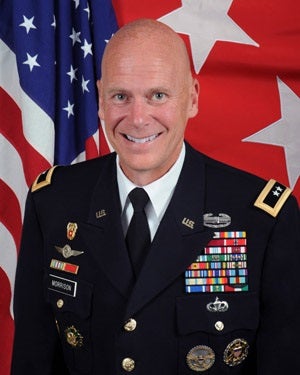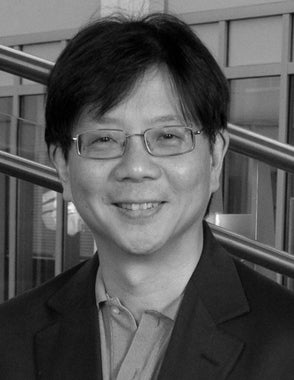GEN Paul M. Nakasone

General Paul M. Nakasone assumed his present duties as Commander, U.S. Cyber Command and Director, National Security Agency/Chief, Central Security Service in May 2018.
He previously commanded U.S. Army Cyber Command from October 2016 - April 2018.
A native of White Bear Lake, Minnesota, GEN Nakasone is a graduate of Saint John's University in Collegeville, Minnesota, where he received his commission through the Reserve Officers' Training Corps.
GEN Nakasone has held command and staff positions across all levels of the Army with assignments in the United States, the Republic of Korea, Iraq, and Afghanistan.
GEN Nakasone commanded the Cyber National Mission Force at U.S. Cyber Command. He has also commanded a company, battalion, and brigade, and served as the senior intelligence officer at the battalion, division and corps levels.
GEN Nakasone has served in Joint and Army assignments in the United States, the Republic of Korea, Iraq, and Afghanistan. His most recent overseas posting was as the Director of Intelligence, J2, International Security Assistance Force Joint Command in Kabul, Afghanistan.
GEN Nakasone has also served on two occasions as a staff officer on the Joint Chiefs of Staff.
GEN Nakasone is a graduate of the U.S. Army War College, the Command and General Staff College, and Defense Intelligence College. He holds graduate degrees from the U.S. Army War College, the National Defense Intelligence College, and the University of Southern California.
GEN Nakasone's awards and decorations include the Distinguished Service Medal (with oak leaf cluster), the Defense Superior Service Medal (with three oak leaf clusters), Legion of Merit, Bronze Star, Defense Meritorious Service Medal (with oak leaf cluster), Army Commendation Medal, Joint Service Achievement Medal (with oak leaf cluster), Army Achievement Medal (with four oak leaf clusters), Joint Meritorious Unit Award, Iraq Campaign Medal, Afghanistan Campaign Medal, Combat Action Badge, and the Joint Chiefs of Staff Identification Badge.
GEN Nakasone and his wife are the proud parents of four children, who form the nucleus of “Team Nakasone.”
MG John B. Morrison, Jr.

Commanding General, U.S. Army Cyber Center of Excellence and Fort Gordon
Major General John B. Morrison, Jr. assumed duties as the Commanding General, U.S. Army Cyber Center of Excellence and Fort Gordon on August 26, 2016.
Major General Morrison, Jr. received his commission through ROTC at James Madison University in Virginia where he graduated in 1986 with a Bachelor of Business Administration degree, majoring in marketing. He also holds a Master of Science Degree in Telecommunications Management from Webster University and a Master of Strategic Resourcing from the Industrial College of the Armed Forces (ICAF).
His military education includes Signal Officer Basic and Advanced Courses, the Tactical Signal Officer’s Staff Course, and the Advanced Airborne (Jumpmaster) School. In addition to ICAF, Major General Morrison is a graduate of both the Command and General Staff College (CGSC) and the Joint Forces Staff College.
His initial assignments were as Platoon Leader and Assistant S-3 in the 1st Signal Battalion, 7th Signal Brigade, in Kaiserslautern, Germany. He later commanded B Company, 1st Signal Battalion and deployed as part of the 93rd Signal Brigade, VII Corps, during the Persian Gulf War. In 1992, he was assigned to Fort Bragg, North Carolina, as the Assistant Brigade S-3, 35th Signal Brigade (Airborne) and then as the Assistant Operations Officer for the 50th Signal Battalion (Corps, Forced Entry, Airborne) where he participated in the Hurricane Andrew relief effort in Florida and provided support for Operation Uphold Democracy. In 1995, he served as an intern in the Office of the Secretary of Defense (OSD) and as an Action Officer on the Army Staff (G-8) in the Pentagon. After CGSC, he served as the Deputy G-6, 1st Cavalry Division and Multi-National Division (North) in Bosnia-Herzegovina and later as the Battalion S-3 for the 13th Signal Battalion, 1st Cavalry Division. He then served in the Command, Control, Communications, and Computers Systems Directorate (J-6), Joint Staff, in Washington DC. Later, he commanded the 13th Signal Battalion (Task Force Mercury) supporting the 1st Cavalry Division and Task Force Baghdad in Iraq. In 2005, he served as the Signal Branch Chief, Human Resources Command, in Alexandria, Virginia, and later commanded the globally deployed Joint Communications Support Element (Airborne) from 2007-2009. At the Pentagon, he was the Executive Officer, Army CIO/G-6 from 2009-2010, and LandWarNet/Mission Command Director in the Department of the Army G-3/5/7 from 2010 to 2012. He served as the Commanding General for the 7th Signal Command (Theater), Fort Gordon, from 2012-2014. From 2014-2016, Major General Morrison served as the Commanding General for the United States Army Network Enterprise Technology Command at Fort Huachuca, Arizona.
Major General Morrison is married to the former Ann Graves, and they have four wonderful daughters – Christine, Kate, Colleen, and Kelly – a son-in-law, Andrew, and a granddaughter, Kaitlyn.
BG Stephen J. Hager
Brigadier General Stephen J. Hager was commissioned in 1987 as a Signal Corps Officer. As an active duty officer he served as Platoon Leader and Executive Officer for Alpha Company, 742nd Military Intelligence Battalion, 704th Military Intelligence Brigade at Fort Meade, Maryland. During Operation Desert Storm he served as the System Control Officer, S-3, 13th Signal Battalion, 1st Cavalry Division. Upon return, he was assigned to the National Security Agency as a Senior Electrical Engineer in the microelectronics advanced research group. Deployed in Operation Restore Hope, he was assigned as the Communications Officer, CENTCOM J-2 Forward in Mogadishu, Somalia.
Hager left active duty, and joined the Army Reserves in 1995, serving in various positions. While in the 91st Division, his assignments included Battle Command Staff Simulation Officer, Company Commander, Observer Controller, G-2 Security Officer, and G-3 Plans Officer.
Mobilized in 2013, he deployed to Afghanistan as the Deputy Commander for the 335th Signal Command (Theater) (Provisional). In Afghanistan, he was responsible for all Architecture, Design, Engineering and Installation of the strategic communication network as well as oversight of communications commercialization projects. Brigadier General Hager most recently deployed to Kuwait as the Chief of Staff for the 335th Signal Command (Theater)(Provisional) in support of Operation Inherent Resolve and Operation Freedom’s Sentinel. In March 2015, Brigadier General Hager was selected as the Deputy Commanding General for the 335th Signal Command (Theater) in East Point, Georgia.
His military education includes the Army Signal Officer Basic Course, Advanced Cryptologic Management Course, Signal Officer Advanced Course, Observer/Controller Course, Mobilization Planners Course, The Combined Arms Services Staff School, the Army Command and General Staff College, the Battalion/Brigade Pre-Command Course, and the Army War College.
Hager’s awards and decorations include the Bronze Star Medal, Defense Meritorious Service Medal, Meritorious Service Medal (sixth award), the Army Commendation Medal (second award), the Army Achievement Medal (third award) and various other campaign and service ribbons. He received a Bachelor of Science Degree in Mathematics and a Master’s of Science Degree in Engineering Computer Science from Santa Clara University. He also received a Master’s of Strategic Studies from the United States Army War College.
Hager resides in Los Gatos, California with his wife, Eve, and their three children, Lauren, Taylor and Bradley. In his civilian career, Hager is a software developer for a technology company in Silicon Valley.
Herb Lin

Herb Lin is a senior research scholar for cyber policy and security at the Center for International Security and Cooperation and the Hank J. Holland Fellow in cyber policy and security at the Hoover Institution, both at Stanford University. His research interests concern the policy-related dimensions of cybersecurity and cyberspace; he is particularly interested in and knowledgeable about the use of offensive operations in cyberspace, especially as instruments of national policy. In addition to his positions at Stanford University, he is chief scientist emeritus for the Computer Science and Telecommunications Board, at the National Research Council (NRC) of the National Academies, where he served from 1990 through 2014 as study director of major projects on public policy and information technology, and adjunct senior research scholar and senior fellow in cybersecurity (not in residence) at the Saltzman Institute for War and Peace Studies in the School for International and Public Affairs at Columbia University. Before his NRC service, he was a professional staff member and staff scientist for the House Armed Services Committee (1986–90), where his portfolio included defense policy and arms control issues. He received his doctorate in physics from the Massachusetts Institute of Technology.
He is also a longtime folk and swing dancer and a poor magician. Apart from his work on cyberspace and cybersecurity, he has published on cognitive science, science education, biophysics, and arms control and defense policy. He also consults on K–12 math and science education.
Moderator:
LTG Paul M. Nakasone
Commanding General
United States Army Cyber Command
Panelists:
MG John B. Morrison, Jr.
Commanding General
United States Army Cyber Center of Excellence
BG Stephen J. Hager
Cyber National Mission Force
United States Cyber Command
Herb Lin
Senior Research Scholar for Cyber Policy and Security
Hank J. Holland Fellow in Cyber Policy and Security, Hoover Institution
Stanford University
Chris Lynch
Leader
Defense Digital Service
Guy Filippelli
Vice President, Solutions
Data and Insider Threat Solutions
Forcepoint

